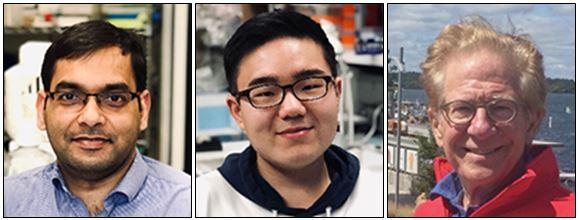
Credit: AlphaMed Press
Durham, NC – The gene p53 is extremely important in cell biology and, hence, the world of cell replacement therapy. Its role is to regulate the cell cycle and halt the formation of tumors, leading to its nickname the “tumor suppressor gene.” However, previous efforts to determine whether p53 is behind programmed cellular death (apoptosis) induced by DNA damage in pluripotent embryonic stem cells (ESCs) produced conflicting results. Initial studies said that it was not; later studies concluded that it was.
A new study released today in STEM CELLS sorts through this maze of contradictions to finally determine that the multiple roles of p53 in cell cycle regulation and apoptosis are acquired during pluripotent stem cell differentiation.
Melvin L. DePamphilis, Ph.D., section chief of Eukaryotic DNA Replication at the National Institute of Child Health & Human Development, Bethesda, MD., conducted the study along with his Institute colleagues Sushil K. Jaiswal, Ph.D., and John J. Oh, post-baccalaureate trainee. “If ESCs are to be used to form the basis of cell replacement therapies, then identifying the role or roles of p53 in pluripotent stem cells is essential,” he said. “Our goal was to finally resolve this question of whether p53 is essential for inducing cell cycle arrest and/or apoptosis prior to ESC differentiation.”
The majority of earlier studies used a chemotherapy drug called Adriamycin/doxorubicin (ADR) to induce apoptosis. ADR impacts DNA replication and mitosis, resulting in the accumulation of double-stranded DNA breaks in proliferating cells. Damaged DNA can trigger p53 to initiate apoptosis and prevent the duplication of damaged chromosomes. As the levels of p53 rise, they prompt production of a protein called p21, which enforces a halt in the cycle dictated by p53. It does this by binding to and inhibiting the activity of the Cdk/cyclin complexes, whose job is to switch the cell cycle off and allow time for the damaged DNA to be repaired.
In the current study, the Institute team likewise induced apoptosis using a 40-fold range of ADR concentrations as well as other chemotherapy drugs (staurosporine and WX8), all tested over a 50-fold range of cell seeding densities. To eliminate the possibility that conclusions depended on either the source or derivation of p53-/- ESCs, both wild-type and p53-/- ESCs derived directly from mouse blastocysts were characterized in parallel with ESCs in which the p53 genes were ablated in vitro from ESCs harboring conditional p53 gene knockouts. “ESCs isolated from p53-/- blastocysts presented a chronic phenotype, whereas p53-/- ESCs engineered in vitro presented an acute phenotype that could be compared directly with their parental ESCs,” Dr. Jaiswal explained.
The results showed that regardless of derivation the ESCs did not require p53, p21 or PUMA (another critical protein involved in apoptosis that is induced by p53) either to activate the G2-checkpoint, which ensures that cells don’t initiate mitosis until damaged DNA is repaired, or to undergo apoptosis rapidly and efficiently. “The effects of ADR concentration and cell confluency were marginal, but the effects of cell differentiation were dramatic; p53 dependent regulation of cell division and apoptosis were acquired during p53-dependent cell differentiation,” Mr. Oh said.
These results led the researchers to conclude that the study “unequivocally” demonstrates that the multiple roles of p53 in cell cycle regulation and apoptosis are first acquired during pluripotent stem cell differentiation.
“The new report by Jaiswal et al. is extremely important in reconciling contradictory results concerning the role of p53 in the stem cell field,” said Dr. Jan Nolta, Editor-in-Chief of STEM CELLS. “The authors have now definitely shown that the importance of p53 in cell cycle arrest and initiation of apoptosis is first acquired during the differentiation of pluripotent stem cells.”
###
The full article, “Cell cycle arrest and apoptosis are not dependent on p53 prior to p53-dependent embryonic stem cell differentiation,” can be accessed at https:/
About the Journal: STEM CELLS, a peer reviewed journal published monthly, provides a forum for prompt publication of original investigative papers and concise reviews. The journal covers all aspects of stem cells: embryonic stem cells/induced pluripotent stem cells; tissue-specific stem cells; cancer stem cells; the stem cell niche; stem cell epigenetics, genomics and proteomics; and translational and clinical research. STEM CELLS is co-published by AlphaMed Press and Wiley.
About AlphaMed Press: Established in 1983, AlphaMed Press with offices in Durham, NC, San Francisco, CA, and Belfast, Northern Ireland, publishes three internationally renowned peer-reviewed journals with globally recognized editorial boards dedicated to advancing knowledge and education in their focused disciplines. STEM CELLS® is the world’s first journal devoted to this fast paced field of research. THE ONCOLOGIST® is devoted to community and hospital-based oncologists and physicians entrusted with cancer patient care. STEM CELLS TRANSLATIONAL MEDICINE® is dedicated to significantly advancing the clinical utilization of stem cell molecular and cellular biology. By bridging stem cell research and clinical trials, SCTM will help move applications of these critical investigations closer to accepted best practices.
About Wiley: Wiley, a global company, helps people and organizations develop the skills and knowledge they need to succeed. Our online scientific, technical, medical and scholarly journals, combined with our digital learning, assessment and certification solutions, help universities, learned societies, businesses, governments and individuals increase the academic and professional impact of their work. For more than 200 years, we have delivered consistent performance to our stakeholders. The company’s website can be accessed at http://www.
Media Contact
Chelsea Kekahuna
[email protected]
Related Journal Article
http://dx.




